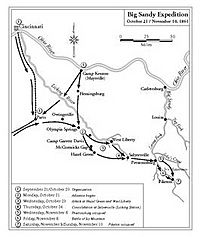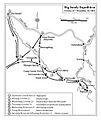Big Sandy Expedition facts for kids
Quick facts for kids Big Sandy Expedition |
|||||||
|---|---|---|---|---|---|---|---|
 |
|||||||
|
|||||||
| Belligerents | |||||||
| Commanders and leaders | |||||||
| B.G.William "Bull" Nelson Col. Joshua W. Sill |
Col. John S. Williams | ||||||
| Units involved | |||||||
| 16th Regiment Kentucky Volunteer Infantry 2nd Ohio Infantry 21st Ohio Infantry 33rd Ohio Infantry 59th Ohio Infantry Battery D, 1st Ohio Light Artillery 1st Ohio Cavalry (B Company) |
5th Kentucky Infantry | ||||||
| Strength | |||||||
| 5,500 (twelve units of Kentucky and Ohio infantry) | 1,010 (nine companies of infantry and five mounted) | ||||||
| Casualties and losses | |||||||
| killed: 6 wounded: 26 |
killed: 31 wounded: 55 captured: 74 |
||||||
The Big Sandy Expedition was an early military operation during the American Civil War in Kentucky. It started in mid-September 1861. Union General William "Bull" Nelson was ordered to gather troops. His mission was to go into the Big Sandy Valley in Eastern Kentucky. He needed to stop Confederate forces led by Colonel John S. Williams. The expedition happened in three main parts. First, Nelson gathered 5,500 Union volunteers from Ohio and Kentucky. Then, his troops moved into different areas. Finally, they fought the Battle of Ivy Mountain, which led to the Confederates leaving Pikeville.
Contents
Why the Expedition Happened: The Background
In early September 1861, Kentucky stopped being neutral in the Civil War. This meant it had to pick a side. Confederate General Leonidas Polk sent troops into Kentucky. The Kentucky government then allowed Union troops to enter the state.
Confederate leaders like Simon Bolivar Buckner and Felix K. Zollicoffer also moved their forces. Zollicoffer's troops in southeastern Kentucky were a threat to Union control. At the same time, more Confederates gathered in the Big Sandy Valley. They seemed ready to move into the central part of Kentucky.
General George Henry Thomas ordered Union troops to stop these movements. Meanwhile, former Vice President John C. Breckinridge and Colonel Humphrey Marshall joined Confederate forces. Marshall took command of the "Army of Eastern Kentucky" near Pikeville.
General Nelson announced his plan to gather volunteers. His goal was to "end treason" in Kentucky. The expedition aimed to protect Union forces in western Virginia. It also hoped to push Zollicoffer's troops back.
Nelson set up his main camp at Olympia Springs. He called it Camp Gill. This area was important because a main road passed through McCormack's Gap. This gap was a key entry point to the Bluegrass Region of Kentucky. Union forces quickly secured this pass. Over two weeks, Nelson's army grew to about 5,500 men. Most were from Ohio and Kentucky.
On the Confederate side, Captains Andrew Jackson May and John Ficklin helped Colonel John S. Williams. They formed the 5th Kentucky Infantry. This unit had about 1,010 men. They were poorly dressed and sometimes called the "Ragamuffin Regiment." Their weapons were not very good for war.
Early Battles: West Liberty and Hazel Green
On October 21, 1861, some Union troops fought Confederates at Wildcat Mountain. The next day, General Nelson ordered 1,600 of his men to advance to West Liberty. They brought two cannons with them.
The following morning, Nelson's main force of 3,500 men reached Hazel Green. After a short fight, 38 out of 200 Confederates surrendered. About 12 miles north, at West Liberty, 500-700 Confederates were defeated. They lost 21 killed, 40 wounded, and 34 captured. The Union lost only two wounded.
Nelson then waited for his supply wagons to catch up. He brought all his forces together at Licking Station, which is now Salyersville. The operation started again on October 31. When they reached Prestonsburg, they found the Confederates had left the town.
| Battle of Ivy Mountain | |||||||
|---|---|---|---|---|---|---|---|
| Part of American Civil War | |||||||
|
|||||||
| Belligerents | |||||||
| Commanders and leaders | |||||||
| William "Bull" Nelson | John S. Williams | ||||||
| Strength | |||||||
| 3,600 | 400 | ||||||
| Casualties and losses | |||||||
| 6 killed, 24 wounded | 10 killed, 15 Wounded, 50 Missing or captured | ||||||
The Battle of Ivy Mountain
On Thursday, November 7, Colonel Joshua W. Sill led a part of the Union force. They moved towards John's Creek. From there, they planned to go south to get behind the enemy at Pikeville. The next morning, Nelson led the main group of 3,600 men towards Pikeville. They used the Old State Road.
It rained very heavily as they got close to Ivy Mountain. This was a long, 1,000-foot-high hill. The Big Sandy River was on their right, making it hard to move. The path was only seven feet wide and full of knee-deep mud. The cannons had to be taken apart and pulled forward one by one.
About 15 miles west of Pikeville, the Union advance guard turned a corner in the path. Suddenly, 250 Confederates appeared. They were hidden about 100 feet up the hill behind rocks and trees. Around 1:00 p.m., the Confederates opened fire. Four Union soldiers were killed, and 13 were wounded.
General Nelson bravely rushed forward. He stood on a rock and told his men that if the Confederates couldn't hit him, they couldn't hit anyone. He ordered the 2nd Ohio Infantry and 21st Ohio Infantry to go up the side of the mountain. Their goal was to attack the enemy from the side. At the same time, Nelson had two small cannons fire directly at the Confederate positions.
Around 2:20 p.m., the 21st Ohio Infantry reached the top of the hill. They rolled large rocks down, making the Confederates run away. Half an hour later, Captain May's men started cutting down trees and burning bridges. This was to slow down the Union pursuit.
The Battle of Ivy Mountain was a clear victory for the Union. Nelson's forces controlled the area. The Union lost 6 killed and 24 wounded. The Confederates had 10 killed, 15 wounded, and 50 missing or captured. Nelson stopped chasing the Confederates at a burned bridge. Colonel Williams continued to Pikeville. He left 400 men to guard the town while the rest of his force retreated to Pound Gap.
At 3:00 a.m. on Saturday, November 9, Nelson's troops started chasing again. Bad road conditions slowed them down. By nightfall, they were still five miles from Pikeville. Early on Sunday, November 10, Nelson was close to Pikeville. A group from Joshua Sill's force met them. They reported that they had secured the town at 4:00 p.m. on Saturday.
In Pound Gap, Colonel Williams reported that Nelson had defeated a group of "unorganized and half-armed" soldiers. These soldiers lacked everything but the will to fight. News reports praised Nelson for moving troops through tough land without good transportation. This surprised Williams, who thought Nelson would go into Virginia. He believed Nelson would try to destroy the Virginia and Tennessee Railroad. This railroad connected the Confederate capital at Richmond, Virginia to Memphis, Tennessee and the Mississippi Valley.
Early news reports about Ivy Mountain were not entirely accurate. People in the North wanted the war to end quickly. This led some to believe the victory was bigger than it was. Some thought the campaign in Eastern Kentucky would not have a lasting effect. They worried that Confederate fighters would quickly undo the Union's work. These concerns led to General Don Carlos Buell replacing General William T. Sherman in Louisville. Nelson was ordered to report there, and his brigade followed. As predicted, the Confederates returned to the region. This led to Colonel James A. Garfield taking over the task of subduing them.
Images for kids


